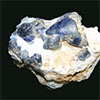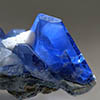Benitoite is one of the world rarest
gemstones, it's a relatively new gemstone,
and was first described in 1907 by George
D. Louderback, who named it benitoite
for its occurrence near the headwaters
of the San Benito River in San Benito
County, California. Large crystals of
benitoite are very rare, and they are
usually preserved as mineral specimens.
Therefore, gemstones of benitoite are
almost always very small, rarely
exceeding two carats. Benitoite typically
occurs with an unusual set of minerals,
along with minerals that make up its host
rock. Frequently associated minerals
include: natrolite, neptunite, joaquinite,
serpentine and albite.
The gemstone possesses many unique
qualities. Benitoite gemstones have
usually sapphire-blue and violet color,
but can range from colorless to dark
blue, and can have very good transparency
and luster. It has a high index of
refraction and a dispersive power higher
than that of diamond, making the stone
extraordinarily bright and fiery when
cut properly. Benitiote has a rare 5
pointed crystal form, and an even rarer
6 pointed form, "star of David", with
about 24 samples known.
Benitoite occurs in a number of sites
including the states of California and
Arkansas and also Japan, but gemstone
quality material has only been found in
San Benito County, California. The
deposit there is no longer actively
producing benitoite, thereby adding to
the scarcity of this gemstone. In 1985
benitoite was named as the official
state gem of California. The largest
7.83 carat weight crystal is stored in
the Smithsonian Museum in Washington,
DC.
Benitoite is not a typical gemstone,
and is mostly reserved for collectors
and connoisseurs of exquisite gemstone.
It is most often cut in round or oval
cuts, though it is not usually seen in
jewelry items. Although Benitoite is a
valuable and exquisite gemstone, its
hardness as a gemstone is relatively
low and it is therefore prone to
scratching. Due to its rarity and lack
of availability, benitoite can be
extremely expensive per carat. Although
benitoite can resemble other gemstone
such as sapphire, iolite, and tanzanite,
its origin is usually enough to
identify it without it getting confused
with other gemstones.

